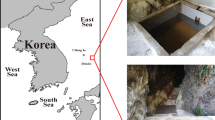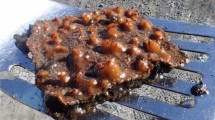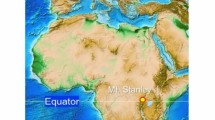Abstract
Caves in Mizoram, Northeast India, are potential hotspot diversity regions due to the historical significance of the formation of the Indo-Burman plateau and also because of their unexplored and unknown diversity. High-throughput paired end Illumina sequencing of the V4 region of 16S rRNA was performed to study the bacterial community of three caves situated in Champhai district of Mizoram, Northeast India. A total of 10,643 operational taxonomic units (OTUs) (based on 97 % cutoff) comprising of 21 major and 21 candidate phyla with a sequencing depth of 1,140,013 were found in this study. The overall taxonomic profile obtained by the RDP classifier and Greengenes OTU database revealed high diversity within the bacterial communities. Communities were dominated by Planctomycetes, Actinobacteria, Proteobacteria, Bacteroidetes, and Firmicutes, while members of Archaea were less varied and mostly comprising of Eukaryoarchea. Analysis revealed that Farpuk (CFP) cave sediment has low microbial diversity and is mainly dominated by Actinobacteria (80 % reads), whereas different bacterial communities were found in the caves of Murapuk (CMP) and Lamsialpuk (CLP). Analysis also revealed that a major portion of the identified OTUs was classified under rare biosphere. Importantly, all these caves recorded a high number of unclassified OTUs, which might represent new species. Further analysis with whole genome sequencing is needed to validate the unknown species as well as to determine their functional role.









Similar content being viewed by others
References
Adetutu EM, Thorpe K, Bourne S, Cao X, Shahsavari E, Kirby G, Ball AS (2011) Phylogenetic diversity of fungal communities in areas accessible and not accessible to tourists in Naracoorte Caves. Mycologia 103:959–968
Adetutu EM, Thorpe K, Shahsavari E, Bourne S, Cao X, Fard RMN, Kirby G, Ball AS (2012) Bacterial community survey of sediments at Naracoorte Caves, Australia. Int J Speleol 41(2):137–147
Aravindraja C, Viszwapriya D, Karutha PS, Ultradeep (2013) 16S rRNA sequencing analysis of geographically similar but diverse unexplored marine samples reveal varied bacterial community composition. PLoS ONE 8(10):e76724. doi:10.1371/journal.pone.0076724
Barton HA (2006) Introduction to cave microbiology: a review for the non-specialist. J Cave Karst Stud 68:43–54
Barton HA (2014) Life in extreme environments: microbial life of cave systems. In: Wagner D (ed) Starving artists: bacterial oligotrophic heterotrophy in caves. De Gruyter, Berlin
Barton AH, Northup ED (2007) Geomicrobiology in cave environments: past, current and future perspectives. J Cave Karst Stud 69:163–178
Barton HA, Spear JR, Pace NR (2001) Microbial life in the underworld: biogenicity in secondary mineral formations. Geomicrobiol J 18:359–368
Brook BW, Sodhi NS, Ng PKL (2003) Catastrophic extinctions follow deforestation in Singapore. Nature 424:420–424
Caporaso JG, Bittinger K, Bushman FD, DeSantis TZ, Andersen GL, Knight R (2010a) PyNAST: a flexible tool for aligning sequences to a template alignment. Bioinformatics 26:266–267
Caporaso JG, Kuczynski J, Stombaugh J, Bittinger K, Bushman FD, Costello EK, Fierer N, Peña AG, Goodrich JK, Gordon JI, Huttley GA, Kelley ST, Knights D, Koenig JE, Ley RE, Lozupone CA, McDonald D, Muegge BD, Pirrung M, Reeder J, Sevinsky JR, Turnbaugh PJ, Walters WA, Widmann J, Yatsunenko T, Zaneveld J, Knight R (2010b) QIIME allows analysis of high-throughput community sequencing data. Nat Methods 7:335–336
Conrad R, Erkel C, Liesack W (2006) Rice Cluster I methanogens, an important group of Archaea producing greenhouse gas in soil. Curr Opin Biotechnol 17:262–267
Cuezva S, Fernandez-Cortes A, Porca E, Pašić L, Jurado V, Hernandez-Marine M, Serrano-Ortiz P, Hermosin B, Carlos Cañaveras J, Sanchez-Moral S, Saiz-Jimenez C (2012) The biogeochemical role of Actinobacteria in Altamira Cave, Spain. FEMS Microbiol Ecol 81:281–290
DeSantis TZ, Hugenholtz P, Larsen N, Rojas M, Brodie EL, Keller K, Huber T, Dalevi D, Hu P, Andersen GL (2006) Greengenes, a chimera-checked 16S rRNA gene database and workbench compatible with ARB. Appl Environ Microbiol 72:5069–5072
Edgar RC (2010) Search and clustering orders of magnitude faster than BLAST. Bioinformatics 26:2460–2461
Edgar RC, Haas BJ, Clemente JC, Quince C, Knight R (2011) UCHIME improves sensitivity and speed of chimera detection. Bioinformatics 27:2194–2200
Ehrich S, Behrens D, Lebedeva E, Ludwig W, Bock E (1995) A new obligately chemolithoautotrophic, nitriteoxidizing bacterium, Nitrospira moscoviensis sp. nov. and its phylogenetic relationship. Arch Microbiol 164(1):16–23
Engel AS, Meisinger DB, Porter ML, Payn R, Schmid M, Stern LA, Schleifer KH, Lee NM (2010) Linking phylogenetic and functional diversity to nutrient spiraling in microbial mats from Lower Kane Cave (USA). ISME J 4:98–110
Epure J, Meleg JN, Munteanu CM, Roban RD, Moldovan OT (2014) Bacterial and fungal diversity of quaternary cave sediment deposits. Geomicrobiol J 31:116–127
Fuerst JA, Sagulenko E (2011) Beyond the bacterium: Planctomycetes challenge our concepts of microbial structure and function. Nat Rev Microbiol 9:403–413
Galagan JE, Nusbaum C, Roy A, Endrizzi MG, MacDonald P, Fitzhugh W, Calvo S, Engels R, Smirnov S, Atnoor D, Brown A, Allen N, Naylor J, Stange-Thomann N, Dearellano K, Johnson R, Linton L, McEwan P, McKernan K, Talamas J, Tirrell A, Ye W, Zimmer A, Barber RD, Cann I, Graham DE, Grahame DA, Guss AM, Hedderich R, Ingram-Smith C (2002) The genome of M. Acetivorans reveals extensive metabolic and physiological diversity. Genome Res 12(4):532–542
Gebauer HD, Chhakchhuak B, Sootinck N (2001) Caves of Mizoram (speleological projects in NE-India) 5:61
Gray CJ, Engel AS (2013) Microbial diversity and impact on carbonate geochemistry across a changing geochemical gradient in a karst aquifer. ISME J 7(2):325–337
Hammer O, Harper DAT, Ryan PD (2001) PAST: paleontological statistics software package for education and data analysis. Palaeontol Electron 4(1):9pp
Hanada S, Hiraishi A, Shimada K, Matsuura K (1995) Chloroflexus aggregans sp. nov., a filamentous phototrophic bacterium which forms dense cell aggregates by active gliding movement. Int J Syst Evol Microbiol 45:676–681
Hugenholtz P, Stackebrandt E (2004) Reclassification of Sphaerobacter thermophilus from the subclass Sphaerobacteridae in the phylum Actinobacteria to the class Thermomicrobia (emended description) in phylum Chloroflexi (emended description). Int J Syst Evol Microbiol 54:2049–2051
Jetten MS, Sliekers O, Kuypers M, Dalsgaard T, van Niftrik L, Cirpus I, van de Pas-Schoonen K, Lavik G, Thamdrup B, Le Paslier D, Op den Camp HJ, Hulth S, Nielsen LP, Abma W, Third K, Engström P, Kuenen JG, Jørgensen BB, Canfield DE, Sinninghe Damsté JS, Revsbech NP, Fuerst J, Weissenbach J, Wagner M, Schmidt I, Schmid M, Strous M (2003) Anaerobic ammonium oxidation by marine and freshwater planctomycete-like bacteria. Appl Microbiol Biotechnol 63:107–114
Jones RT, Robeson MS, Lauber CL, Hamady M, Knight R, Fierer N (2009) A comprehensive survey of soil acidobacterial diversity using pyrosequencing and clone library analyses. ISME J 3:442–453
Kersters K, De Vos P, Gillis M, Swings J, Vandamme P, Stackebrandt E (2006) In: Dwarkin M, Falkow S, Rosenberg E, Schleifer KH, Stackebrandt E (eds) Introduction to the Proteobacteria. The prokaryotes, Vol. 5. Springer, New York, pp 3–37
Li J, Tan B, Mai K, Ai Q, Zhang W, Xu W, Liufu Z, Ma H (2005) Comparative study between probiotic bacterium Arthrobacter XE-7 and chloramphenicol on protection of Penaeus chinensis post-larvae from pathogenic vibrios. Aquaculture 253:140–147
Lozupone C, Knight R (2005) UniFrac: a new phylogenetic method for comparing microbial communities. Appl Environ Microbiol 71:8228–8235
Lü Z, Lu Y (2012) Complete genome sequence of a thermophilic methanogen, Methanocella conradii HZ254, isolated from Chinese rice field soil. J Bacteriol 194(9):2398–2399
MacLeod FA, Guiot SR, Costerton JW (1990) Layered structure of bacterial aggregates produced in an upflow anaerobic sludge bed and filter reactor. Appl Environ Microbiol 56:1598–1607
Maymó-Gatell X, Chien YT, Gossett JM, Zinder SH (1997) Isolation of a bacterium that reductively dechlorinates tetrachloroethene to ethane. Science 276:1568–1571
Minyard ML, Bruns MA, Liermann LJ, Buss HL, Brantley SL (2012) Bacterial associations with weathering minerals at the Regolith-Bedrock interface, Luquillo Experimental Forest, Puerto Rico. Geomicrobiol J 29:792–803
Moss JA, Nocker A, Snyder RA (2011) Microbial characteristics of a submerged karst cave system in Northern Florida. Geomicrobiol J 28:719–931
Myers N, Mittermeier RA, Mittermeier CG, da Fonseca GAB, Kent J (2000) Biodiversity hotspots for conservation priorities. Nature 403:853–858
Northup DE, Melim LA, Spilde MN, Hathaway JM, Garcia MG, Moya M, Stone FD, Boston PJ, Dapkevicius MLNE, Riquelme C (2011) Lava cave microbial communities within mats and secondary mineral deposits: implications for life detection on other planets. Astrobiology 11:601–618
Ortiz M, Neilson JW, Nelson WM, Legatzki A, Byrne A, Yu Y, Wing RA, Soderlund CA, Pryor BM, Pierson LS, Maier RM (2013) Profiling bacterial diversity and taxonomic composition on speleothem surfaces in Kartchner Caverns, AZ. Microb Ecol 65:371–383
Ortiz M, Legatzki A, Neilson JW, Fryslie B, Nelson WM, Wing RA, Soderlund CA, Pryor BM, Maier RM (2014) Making a living while starving in the dark: metagenomic insights into the energy dynamics of a carbonate cave. ISME J 8:478–491
Pohlman JW, Iliffe TM, Cifuentes LA (1997) A stable isotope study of organic cycling and the ecology of an anchialine cave ecosystem. Mar Ecol Prog Ser 155:17–27
Reid A, Buckley M (2011) Washington, DC: American Academy of Microbiology. The rare biosphere: a report from the American Academy of Microbiology
Saiz-Jimenez C (2012) Microbiological and environmental issues in show caves. World J Microbiol Biotechnol 28:2453–2464
Sakai S, Takaki Y, Shimamura S, Sekine M, Tajima T, Kosugi H, Ichikawa N, Tasumi E, Hiraki AT, Shimizu A, Kato Y, Nishiko R, Mori K, Fujita N, Imachi H, Takai K (2011) Genome sequence of a mesophilic hydrogenotrophic methanogen Methanocella paludicola, the first cultivated representative of the order Methanocellales. PLoS One 6(7):e22898
Schabereiter-Gurtner C, Saiz-Jimenez C, Piñar G, Lubitz W, Rölleke S (2002) Altamira cave Paleolithic paintings harbour partly unknown bacterial communities. FEMS Microbiol Lett 211:7–11
Schmid M, Twachtmann U, Klein M, Strous M, Juretschko S, Jetten M, Metzger JW, Schleifer KH, Wagner M (2000) Molecular evidence for genus level diversity of bacteria capable of catalyzing anaerobic ammonium oxidation. Syst Appl Microbiol 23:93–106
Sekiguchi Y, Yamada T, Hanada S, Ohashi A, Harada H, Kamagata Y (2003) Anaerolinea thermophila gen. nov., sp. nov. and Caldilinea aerophila gen. nov., sp. nov., novel filamentous thermophiles that represent a previously uncultured lineage of the domain Bacteria at the subphylum level. Int J Syst Evol Microbiol 53:1843–1851
Stomeo F, Makhalanyane TP, Valverde A, Pointing SB, Mark I, Steven MI, Cary CS, Tuffin MI, Cowan DA (2012) Abiotic factors influence microbial diversity in permanently cold soil horizons of a maritime-associated Antarctic Dry Valley. FEMS Microbiol Ecol 82:326–340
Strapoc D, Picardal FW, Turich C, Schaperdoth I, Macalady JL, Lipp JS, Lin YS, Ertefai TF, Schubotz F, Hinrichs KU, Mastalerz M, Schimmelmann (2008) A methane-producing microbial community in a coal bed of the Illinois basin. Appl Environ Microbiol 74(8):2424–2432
Tetu SG, Breakwell K, Elbourne LD, Holmes AJ, Gillings MR, Paulsen IT (2013) Life in the dark: metagenomic evidence that a microbial slime community is driven by inorganic nitrogen metabolism. ISME J 7:1227–1236
Thomsen TR, Finster K, Ramsing NB (2001) Biogeochemical and molecular signatures of anaerobic methane oxidation in a marine sediment. Appl Environ Microbiol 67:1646–1656
Waldron PJ, Petsch ST, Martini AM, Nüsslein K (2007) Salinity constraints on subsurface archaeal diversity and methanogenesis in sedimentary rock rich in organic matter. Appl Environ Microbiol 73(13):4171–4179
Ward NL, Challacombe JF, Janssen PH, Henrissat B, Coutinho PM, Wu M, Xie G, Haft DH, Sait M, Badger J, Barabote RD, Bradley B, Brettin TS, Brinkac LM, Bruce D, Creasy T, Daugherty SC, Davidsen TM, Deboy RT, Detter JC, Dodson RJ, Durkin AS, Ganapathy A, Gwinn-Giglio M, Han CS, Khouri H, Kiss H, Kothari SP, Madupu R, Nelson K, Nelson WC, Paulsen I, Penn K, Ren Q, Rosovitz MJ, Selengut JD, Shrivastava S, Sullivan SA, Tapia R, Thompson LS, Watkins KL, Yang Q, Yu C, Zafar N, Zhou L, Kuske CR (2009) Three genomes from the phylum Acidobacteria provide insight into their lifestyles in soils. Appl Environ Microbiol 75:2046–2056
Watson SW, Bock E, Valois FW, Waterbury JB, Schlosser U (1986) Nitrospira marina gen. nov. sp. nov.: a chemolithotrophic nitrite-oxidizing bacterium. Arch Microbiol 144(1):1–7
Wexler HM (2007) Bacteroides: the good, the bad, and the nitty-gritty. Clin Microbiol Rev 20(4):593–621
Wu Y, Tan L, Liu W, Wang B, Wang J, Cai Y, Lin X (2015) Profiling bacterial diversity in a limestone cave of the western Loess Plateau of China. Front Microbiol 6:244
Acknowledgments
This research was supported by a grant from the State Biotech Hub and Bioinformatics Infrastructure Facility sponsored by Department of Biotechnology, Govt. of India, New Delhi.
Author information
Authors and Affiliations
Corresponding author
Additional information
Responsible editor: Robert Duran
Nucleotide sequence accession number
Paired end Illumina sequence data from this study were submitted to the NCBI Sequence Read Archive (SRA) under accession numbers SRA064116, SRA064118, and SRA064120.
Electronic supplementary material
Below is the link to the electronic supplementary material.
Table S1
Top ten bacterial genera based on OTU number among the cave samples.
Table S2
Top ten OTUs based on total read count number among the cave samples.
Table S3
Pearson’s correlation coefficient between soil characteristics and bacterial phyla.
Figure S1
Graphical representation of the relative abundance of bacterial diversity from phylum to species level of CFP using the Krona visualization tool.
Figure S2
Graphical representation of the relative abundance of bacterial diversity from phylum to species level of CLP using Krona visualization tool.
Figure S3
Graphical representation of the relative abundance of bacterial diversity from phylum to species level of CMC using the Krona visualization tool.
Rights and permissions
About this article
Cite this article
De Mandal, S., Zothansanga, Panda, A.K. et al. MiSeq HV4 16S rRNA gene analysis of bacterial community composition among the cave sediments of Indo-Burma biodiversity hotspot. Environ Sci Pollut Res 23, 12216–12226 (2016). https://doi.org/10.1007/s11356-016-6423-9
Received:
Accepted:
Published:
Issue Date:
DOI: https://doi.org/10.1007/s11356-016-6423-9




